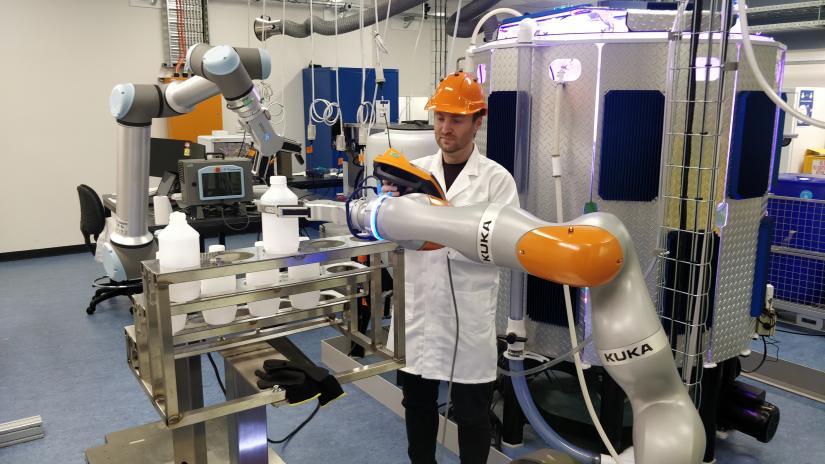In partnership with the NSW government, UTS researchers have developed a set of practical guidelines to enable the safe use of collaborative robots, or cobots, in the workplace.

UTS robotics expert Dr Marc Carmichael in the lab with a cobot. Image: supplied.
Recognising concerns and gaps in current work, health and safety knowledge and practices, researchers have developed new guidelines, built on five fundamental principles, to enable the safe use of collaborative robots, or cobots, in the workplace.
Renowned science fiction writer Isaac Asimov famously devised three laws of robotics to safeguard humans against potential harm from robots and ensure their safe use in society.
However, when it comes to cobots, the challenge is not so much malevolent intent, but rather preventing harm and ensuring compliance with work health and safety when these machines are introduced into Australian workplaces.
Although safer than traditional robots, cobots still pose hazards if used inappropriately. This includes physical injuries from collisions, crushing or pinching accidents, or the unsafe use of end-effectors (the tools at the end of a robotic arm), potential cybersecurity risks from hacking, as well as social and ethical challenges and increased stress on workers to learn new skills and routines.
A joint team from the University of Technology Sydney (UTS) and the Centre for Inclusive Design recently partnered with the NSW Government’s Centre for Work Health and Safety to develop a comprehensive set of practical guidelines aimed at supporting safe use of cobots in the workplace.
The Guidelines for Safe Collaborative Robot Design and Implementation offers businesses a set of practical, evidence-based tools that they can use to help review and analyse cobot design, implementation, and management in the workplace.
These new guidelines will shape industry practices in New South Wales, Australia, and beyond, supporting businesses of all sizes to safely adopt and deploy intelligent robotics and automation in their workplaces
Led by Dr Matthias Guertler from the Centre for Advanced Manufacturing, together with Dr Marc Carmichael, Dr Gavin Paul and Dr Nathalie Sick, the project involved an interdisciplinary team of experts specialising in robotics, systems engineering, and human-centered design.
“Cobots, in contrast to traditional industrial robots, are specifically designed to collaborate with humans to support them with strenuous or iterative tasks. They are versatile machines capable of performing multiple tasks, and they’re at the heart of Advanced Manufacturing and Industry 4.0,” Dr Guertler explains.
“These new guidelines will shape industry practices in New South Wales, Australia, and beyond, supporting businesses of all sizes to safely adopt and deploy intelligent robotics and automation in their workplaces,” he said.
According to Dr Guertler, cobot workplace safety encompasses not only technical aspects but also social, ethical, and psychological considerations when designing a safe workplace.
“While we typically associate workplace cobots with arm-based manipulators used in manufacturing, our aim with these guidelines is to encompass the growing variety of collaborative robots, from sheep-shearing to cleaning, customer service in restaurants, and even in health care” he said.
The guidelines are built upon five fundamental principles to establish a safe cobot workplace:
- understanding cobot tasks and safety features
- maintaining a human-centered approach
- aligning cobots with workflow processes
- ensuring cybersecurity protection
- supporting ease of use.
They have been systematically tested and analysed to enhance work health and safety outcomes for businesses and workers, and are now available on the Centre for Work Health and Safety website.

